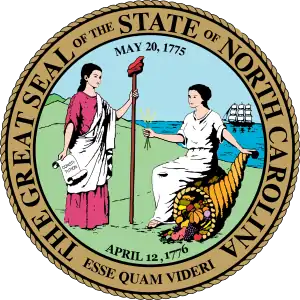Abner Nash
Abner Nash (August 8, 1740 – December 2, 1786) was the second Governor of the U.S. state of North Carolina between 1781 and 1782, and represented North Carolina in the Continental Congress from 1782 to 1786.
Abner Nash | |
|---|---|
 | |
| 2nd Governor of North Carolina | |
| In office April 20, 1780 – June 26, 1781 | |
| Preceded by | Richard Caswell |
| Succeeded by | Thomas Burke |
| Personal details | |
| Born | August 8, 1740 Prince Edward County, Colony of Virginia, British America |
| Died | December 2, 1786 (aged 46) New York City, New York, U.S. |
| Political party | None |
Life story
Nash was born the son of Col. John Nash and Anne Owen[1] at "Templeton Manor" Plantation in Prince Edward County in the Colony of Virginia. He read law and was admitted to the bar in Virginia. He also began his political career there, serving in the House of Burgesses from 1761 to 1765, before moving to New Bern, North Carolina. He married the widow of former colonial governor Arthur Dobbs.[2][3][4]
Nash was an active supporter of the revolutionary cause. He represented New Bern in the rebel "provincial congress" assembled from 1774, and in 1776 was a member of the committee that drafted the state's new constitution. He became a member of the North Carolina House of Commons in 1777 (serving as the first Speaker of that house) and the North Carolina State Senate in 1779.[3][4]
He was elected governor by the legislature in 1780. During his brief tenure as governor, North Carolina saw some of its worst conflicts as a battleground in the American Revolutionary War. Unlike his brother Francis, his temper and poor health were poorly suited to the needs of war. This brought him into difficulty with the legislature. The assembly appointed Richard Caswell as commander-in-chief (Major General) of the North Carolina militia and state troops, even though the constitution assigned this responsibility to the governor. Then in December 1780 they named a Council Extraordinary that further encroached on his office. Consequently, Nash resigned and went home in spring 1781. Thomas Burke was named to replace him.[3][4]
Death
Later in 1782, North Carolina eased political tensions by sending Nash as a delegate to the Continental Congress. He would serve there the rest of his life, as he died at a session in New York City. Abner was originally buried in St. Paul's Churchyard in Manhattan, but his body was later returned for burial in a private, family plot in Craven County, North Carolina.[3][4]
Family
His son, Frederick Nash, was also a lawyer and political leader. He would serve as Chief Justice of the North Carolina Supreme Court. Another descendant, also named Frederick, would later become a famous poet, going by his middle name, Ogden Nash.
References
- Note a common report that she was the daughter of Sir Hugh Owen 2nd Baronet of Orielton Wales is incorrect (Sir Hugh daughter Anne Owen died unmarried) See, page 47 of "Memoirs of Ancient Family of Owen of Orielton, Co Pembroke" pub 1886]
- Authur Dobbs Esquire 1689–1765
- Nash, Jaquelin Drane (1991). "Abner Nash". NCPedia. Retrieved April 16, 2019.
- Angley, Wilson (2004). "Abner Nash". NCPedia. Retrieved April 16, 2019.
- "Abner Nash Papers". North Carolina State Archives, Raleigh, NC, USA. Retrieved April 16, 2019.
- Hamilton, Joseph Grégoire de Roulhac (1909). "Presentation of portrait of Governor Abner Nash to the State of North Carolina in the hall of the House of Representatives, at Raleigh, November 15, 1909, by the North Carolina Society of the Sons of the Revolution".
- Malone, Dumas (1932). Dictionary of American biography. Vol. 13. London: Milford.
- Powell, William Stevens (1991). Dictionary of North Carolina biography. Vol. 4, L–O. Chapel Hill: University of North Carolina Press.
External links
| Political offices | ||
|---|---|---|
| Preceded by Richard Caswell |
Governor of North Carolina 1780–1781 |
Succeeded by Thomas Burke |
